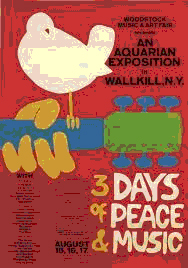We all know Howard Mills was a former NYSID Superintendent. Many of us also know he was a New York legislator. Some even know that his long-time political role model is Teddy Roosevelt. Very few, however, are aware of how closely linked our former superintendent is to the legendary Woodstock Music and Art Fair.
Although many still believe that the 1969 festival was actually held in Woodstock, that’s not the case. Early on, Woodstock organizer Michael Lang dismissed the rustic, unconventional town as a possible site. He felt it too small to fit his grand vision of the gathering. He insisted, however, on keeping the name Woodstock because he felt it conjured up earthy, mystical images. The gig has “gotta be called Woodstock,” said Lang, “no matter where it goes down."

In searching for a suitable location, Lang’s staff came across a piece of property owned by Howard Mills’ father (also named Howard) located in the Town of Wallkill. Although the Town of Wallkill may have lacked a mystical name, the Mills property seemed ideal.
In “Barefoot in Babylon,” a behind-the-scenes account of the origins of the historic festival, author Bob Spitz notes that organizers initially minimized the potential impact of the event when they presented Mills with their proposal to lease his property. According to Spitz, the organizers told Mills the festival “would encompass some music, probably small concerts, featuring a few of the area’s finer musicians.”
Mills was intrigued by the idea and, after receiving approvals from the Town of Wallkill’s Zoning Board of Appeals, signed a contract to lease the site to the festival organizers.
When word got out in the community about the festival, resistance began to simmer. When working through appropriate channels didn’t seem to achieve the desired results for the opposition, threatening calls were made to festival organizers. Lang and his associates, however, were confident that the festival would go on as planned. After all, they had a contract and the appropriate approvals were in place.
Tractors began clearing the area. Dead trees were in place to use for constructing the stage. Access roads were being built. But the threatening phone calls had now intensified. Howard’s Mom and Dad were now getting phone calls; one caller claimed he would burn down Mills’ home if he didn’t stop the festival.
At one point, Howard’s Dad suggested his wife and children leave the area for the remainder of the summer, but Howard’s Mom quickly ruled out that option. The pressure was also intense on Wallkill’s town officials. Then, on July 15, only 31 days before the festival was scheduled to start, the Town of Wallkill Zoning Board of Appeals issued an injunction, ruling that all construction must stop at the site.
Organizers didn’t have time to fight the move. They were forced to pull up stakes and look elsewhere. Enter Max Yasgur and his farm in Bethel, New York. The rest is history.
Since it was too late to remove the Wallkill site from much of the Woodstock promotional material, the town’s name was prominently displayed on publicity posters and brochures from that era, which just adds to the confusion. Woodstock was not held in Woodstock, was advertised as taking place in Wallkill, but actually occurred in Bethel. Many of those posters and brochures are considered collectors items today.
Howard and his family will always be tangentially linked to the Woodstock festival. But who knows? Had the festival actually gone down on Mills’ property, the lyrics to Joni Mitchell’s “Woodstock” may have been somewhat different:
I came upon a child of God
He was walking along the road
And I asked him where are you going
This is what he told me
I'm going on down to Howie's farm
I'm going to join in a rock 'n' roll band
I'm going to camp out on the land
I'm going to try an' get my soul free...
You can learn more about the role of Howard’s family in Woodstock from “Barefoot in Babylon” or by visiting the Woodstock Museum in Saugerties, New York.